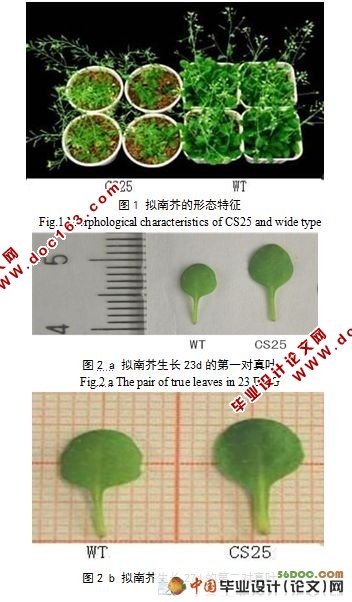拟南芥转座子插入突变体CS27715的筛选及形态学观察

摘 要:拟南芥是一种模式植物,在植物学研究中有重要意义。本试验是对拟南芥CS27715(CS25)基因突变体材料进行筛选, 通过育种发芽、提取DNA、PCR扩增和琼脂糖凝胶电泳等步骤筛选突变体,获得了CS25杂合子突变体。对CS25杂合子表型进行了初步形态学观察,结果显示:CS25杂合子突变体植株与野生型植株相比较,突变体植株矮小;叶片少,叶片表皮毛数量少,叶缘全缘;花柄短,花序集中;果荚长短径比值小;种子呈短椭圆型。
关键词:拟南芥;转座子CS25突变体;筛选
Screening of Transposable Elements Insertion Mutant(CS27715)in Arabidopsis and Morphology Observation
Abstract:Arabidopsis is a pattern of plants and it has a great significance in botany research. In this study, we screened the heterozygous and homozygotes of CS27715 (CS25) heterozygous in Arabidopsis by PCR amplification. Then, with a particular morphology observation, the result showed that CS25 heterozygous mutant plants compared with wild-type plants, mutant plants stunted; leaves small, leaf table fur small, entire leaf edges; flower handles short, inflorescence concentrated; the pod is length ratio of small diameter; seeds are short elliptic.
Keywords: Arabidopsis; Transposon insertion mutation CS25; Screening [版权所有:http://DOC163.com]

目 录 8000字
摘要………………………………………………………………………………………1
关键词………………………………………………………………………………………1
1前言……………………………………………………………………………………1 [来源:http://Doc163.com]
1.1拟南芥简介………………………………………………………………………2
1.2转座子和转座子突变体的介绍………………………………………………2
1.2.1 转座子介绍………………………………………………………………2
1.2.2 转座子突变体介绍………………………………………………………3
2材料与方法…………………………………………………………………………4
[版权所有:http://DOC163.com]
2.1材料……………………………………………………………………………4
2.1.1试验材料…………………………………………………………………4
2.1.2试验试剂…………………………………………………………………4
2.1.3主要仪器…………………………………………………………………4
2.2方法………………………………………………………………………………4 [资料来源:https://www.doc163.com]
2.2.1材料处理…………………………………………………………………4
2.2.2 DNA的抽提………………………………………………………………5
2.2.3提取的基因组DNA电泳检测…………………………………………5
2.2.4引物的设计与合成………………………………………………………5
2.2.5 PCR扩增…………………………………………………………………6
2.2.6 PCR产物的电泳检测……………………………………………………7
3结果与分析………………………………………………………………………………7
3.1拟南芥CS25突变体(杂合子)和野生型植株形态特征………………7
3.2 拟南芥CS25突变体(杂合子)和野生型生长状态区别………………11
3.3 基因组DNA提取后的电泳检测结果………………………………………11
3.4 PCR产物电泳检测结果……………………………………………………12
[资料来源:Doc163.com]
4讨论…………………………………………………………………………………12
5结论……………………………………………………………………………13
参考文献 ………………………………………………………………………13
致谢……………………………………………………………………………14
[来源:http://www.doc163.com]
